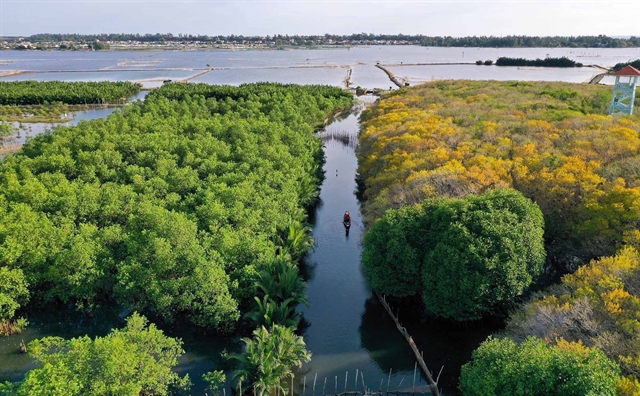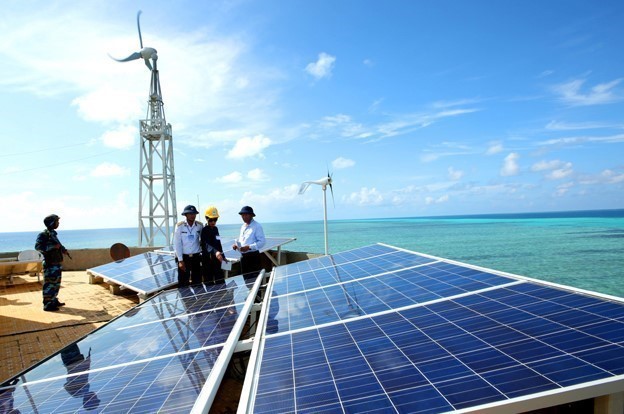 Environment
Environment


|
| Rú Chá, a primeval mangrove forest in the Tam Giang Lagoon system, the central province of Thừa Thiên-Huế. — VNA/VNS Photo Hồ Cầu |
Caitlin Wiesen* UNDP Resident Representative
As we celebrate World Environment Day, this year’s theme: “Time for Nature,” could not be more vital. It is a reminder for all of us that nature is the essential foundation for life on earth. “The foods we eat, the air we breathe, the water we drink, and the climate that makes our planet habitable all come from nature.” (UN World Environment Day). Our lives and our economies rely heavily on a healthy, richly biodiverse environment. Therefore, to care for ourselves, we must care for nature.
The good news is that the United Nations has declared that 2021-2030 as the UN Decade on Ecosystem Restoration. In the lead up to the new decade, 2020 was an important year preparing a new global biodiversity framework, however these plans have been disrupted by the current crisis triggered by COVID-19 pabdemic. Yet the issues they address are more relevant as ever. Việt Nam has provided exemplary leadership in the successful containment of COVID-19 pandemic by putting the health and lives of people first. It now has the opportunity as a global front runner in opening to a ‘new normal’ to lead with solutions that are nature based and sustainable.
Việt Nam has important foundations to build on. Việt Nam ranks 16th out of the 25 countries which have the richest biodiversity in the world. Dozens of different ecosystems and habitats – including forests, grasslands, mountains, rivers, peat swamps, coastal mangroves, and coral reefs – all play host to thousands of native and migratory species, hundreds of which can only be found within the country’s borders. At present, Việt Nam has one of the highest proportions of threatened species in the world, including over 500 that may be risking extinction. Việt Nam’s nature provides strong foundation for sustainable economic growth, especially the sectors of agriculture, forestry, fisheries, tourism and hospitality, medicinal, renewable energy, and textile and apparel. There are promising recent developments in the fisheries, agriculture and textile and apparel that point to clear evidence of successful nature-based development in Việt Nam.
Việt Nam has made many efforts to protect natural resources and biodiversity, such as by establishing a comprehensive natural conservation sites and protected areas. The people of Việt Nam also engage in local-level conservation work, such as the Dao ethnic minority, who continue to practice traditional lifestyles that involve the sustainable extraction of non-timber products from their community forests.
Unfortunately, nature, biodiversity and ecosystems in Việt Nam are increasingly threatened by unsustainable business practices, depleting soil, water and degrading ecosystems driven by population growth, urbanization, industrial expansion, infrastructure development and pollution. We will only be able to continue benefiting from natural resources for as long as we can protect them. If we are to find a long-term solution for dealing with biodiversity loss and ecosystem degradation, it will lie in an integrated approach to socio-economic development of significant scope, ambition and speed.
As we see with the current COVID-19 pandemic and other communicable diseases, the imbalance of the natural environment due to human actions is creating more opportunities for such global health problems to emerge.
According to Kate Jones, chair of ecology and biodiversity at University College London, “simpler systems get an amplification effect. Destroy landscapes, and the species you are left with are the ones humans get the diseases from.” We should not forget that humans interact with the ecosystems around them to form a self-regulated system to maintain the balance of nature, as such, a well-BALANCED ecosystem can play a role in limiting the transmission of new diseases.
Although the current COVID-19 crisis caused unpreceded impacts, it is also presenting an unprecedented opportunity to rebuild in a sustainable, environmentally harmonious way. The so-called “dividend for nature” precipitated by the pandemic over the past few months has been the result of a radical restructuring of our lives and societies. The International Energy Agency estimates that the impact of the virus may cause a drop in total global emissions of up to 8 per cent this year, a reduction twice as large as the combined summation of all previous drops since 1945.
A critical question at this time is how can we shape the pandemic recovery towards sustainable, resilient pathways that will also preserve the nature that is essential to Việt Nam’s future? While the challenges are undeniably daunting, we already have an array of promising options, some of which are already being implemented, others need new thinking and design.
First, conservation and protection are essential measures to ensure the balance of nature. It is essential to enhance actions to create and maintain natural protected areas systems here in Việt Nam and around the world. Việt Nam has been making significant efforts in establishing a comprehensive protected areas system with 16 marine protected areas, more than 126 terrestrial protected areas, 9 biosphere sites, and new wetland protected areas. UNDP provided support to the establishment of two new wetland protected areas of Thái Thuỵ in Thái Bình in 2019 and today, on World Environment Day, we are delighted that Tam Giang-Cầu Hai Lagoon in the central province of Thừa Thiên-Huế has been officially declared a protected area. This is a commendable progress, but continued effort is needed to ensure effective management and development of the Protected Area system and to increase finance for biodiversity to bring about sustainable benefits for local communities and the economy of Việt Nam.
Second, the acceleration of the transformation towards low-carbon and green economy is vital to ensure future sustainable development is within planetary boundaries. Việt Nam has made significant efforts in introducing necessary policies for green growth, but everyone has a role to play. Whether directly or indirectly, our decisions all have an impact on nature, from the clothes we wear to the way in which we design and power our homes. A shift towards sustainable production and consumption and lifestyles through raising awareness and promoting social norms on using environmentally friendly products is needed to change our behaviours toward environmental protection. The role of the private sector is paramount: if there is consumer demand for eco-friendly products and services, business must rise to meet the market.
Việt Nam is also endowed with significant exploitable renewable energy has major unused opportunities for energy savings. As Việt Nam is currently revising its 8th Power Development Plan and is preparing the next 10-year SEDS, the accelerating the deployment of full renewable energy potentials, especially solar and wind energy, and scaling up energy efficiency measures throughout all sectors of the economy will avoid future GHG emissions that is accelerating climate change and destroying vital ecosystems.

|
| Solar energy and wind energy systems installed on Núi Le Island in Trường Sa (Spratly) archipelago, Khánh Hoà Province. — VNA/VNS Photo Ngọc Hà |
Finally, the promotion of nature-based solutions for development is a must, not an option. As climate change is happening faster than we anticipated and affecting biodiversity and ecosystems in immense ways, nature-based solutions play a vital role to help reduce shocks and adapt to new risks. For example, mangrove forests and wetland ecosystems have special roles in filtering pollution, supporting livelihoods for local communities, and protecting the infrastructure and lives of people who live in or near them. In Việt Nam, 12 million hectares of wetlands nationwide provide primary livelihoods and additional income for around 20 million Vietnamese people, but they also act as storm surge buffer zones, carbon sinks and also work towards reducing saline intrusion prevention. UNDP, through its GCF coastal resilience project, is supporting the rehabilitating and regenerating 4,000 hectares of coastal mangroves to protect vulnerable communities whose lives and livelihoods are being impacted by the climate crisis. Việt Nam has a history of living in harmony with nature that needs to be recognised and harnessed, and its ethnic minorities are keepers of an accumulation of valuable traditional knowledge and nature-based solutions that should be nurtured.
As we move forward into the Decade of Restoration, it is time we look beyond merely coexisting with nature, to fully acknowledging our place in nature as part of a larger, harmonious whole. Our health for current and future generations and the health of our planet depend on it.




